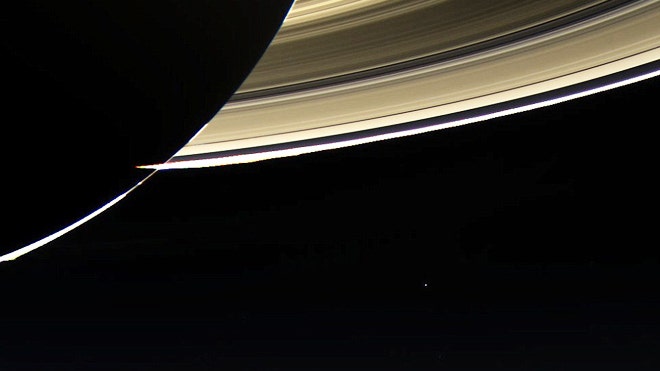

A photo by the Cassini spacecraft shows the rings of Saturn, with Earth a faint blue dot in the distance. (NASA/JPL/Cassini/Guillermo Abramson)
Carl Sagan once famously referred to the Earth as, “where we make our stand.”
NASA’s Cassini spacecraft photos from over 900 million miles away are simply breathtaking. Looking at that pale, blue dot he described suddenly makes sense. It’s our home – but just one tiny speck barely visible in the infinitely vast reach of space.
One very important speck, that is:
Look again at that dot. That’s here. That’s home. That’s us. On it everyone you love, everyone you know, everyone you ever heard of, every human being who ever was, lived out their lives. The aggregate of our joy and suffering, thousands of confident religions, ideologies, and economic doctrines, every hunter and forager, every hero and coward, every creator and destroyer of civilization, every king and peasant, every young couple in love, every mother and father, hopeful child, inventor and explorer, every teacher of morals, every corrupt politician, every “superstar,” every “supreme leader,” every saint and sinner in the history of our species lived there — on a mote of dust suspended in a sunbeam.
The Earth is a very small stage in a vast cosmic arena. Think of the endless cruelties visited by the inhabitants of one corner of this pixel on the scarcely distinguishable inhabitants of some other corner, how frequent their misunderstandings, how eager they are to kill one another, how fervent their hatreds. Think of the rivers of blood spilled by all those generals and emperors so that, in glory and triumph, they could become the momentary masters of a fraction of a dot. From Carl Sagan’s “Pale Blue Dot: A Vision of the Human Future in Space.
High above the planet Saturn on Friday, Cassini snapped photographs of that tiny appearing pixel we live on, backlit by Saturn’s rings. If you looked at the skies, chances are you were photographed from space by NASA’s Cassini spacecraft, almost a billion miles away, and you were not the only one.
A photo by the Cassini spacecraft shows the rings of Saturn, with Earth a faint blue dot in the distance. (NASA/JPL/Cassini/Guillermo Abramson)
For the first time in the nine years the spacecraft had been in orbit, Earth’s inhabitants knew that their photos would be taken and came out to take part in “The Day that the Earth Smiled.” Scientists knew this and a social media campaign had been waged in the weeks prior, urging us Earthlings to participate in the event.
Carolyn Porco, the leader of Cassini’s Imaging Team and the founder of “The Day that the Earth Smiled,” tweeted after the unique interplanetary photo-op, gushing.
Back on Earth, photos were shared via a NASA Flickr gallery and Tweets hashtagged #DayEarthSmiled and #WaveatSaturn. Cassini began to beam down raw images on Saturday and fans began to produce unofficial color pictures.
Guillermo Abramson, a physicist at Argentina’s Bariloche Atomic Center, posted his attempts on his Facebook page. He then explained that the pictures are produced with both wide angle and telephoto lens. Each image has different filters, so they must all be combined to get cohesive colors. In addition, the spacecraft was moving between shots, so the images must be aligned.
Val Klavans, an image processor and social-media leader for a film project, “In Saturn’s Rings,” uploaded her version of the finished product on Flickr.
A mixture of Earth images are set to be used in a mosaic of Friday’s cosmic event. Astronomers Without Borders are gathering photos of Saturn in an attempt to see the planet “as ordinary people do.” An interactive image of Saturn’s rings will be created, but “when you zoom in you’ll see all the pictures from Earth that the mosaic is made of,” the organization’s website explained.
According to the Cassini team website, Porco said that the first official images will be processed and released within the next few days and a mosaic – of Saturn, its rings and Earth – will be completed within six weeks.
“I can’t wait to see the entire mosaic,” Klavans tweeted.
The moment is best captured in a tweet from one of the participants:
The most damning journalistic sin committed by the media during the era of Russia collusion…
The first ecological study finds mask mandates were not effective at slowing the spread of…
On "What Are the Odds?" Monday, Robert Barnes and Rich Baris note how big tech…
On "What Are the Odds?" Monday, Robert Barnes and Rich Baris discuss why America First…
Personal income fell $1,516.6 billion (7.1%) in February, roughly the consensus forecast, while consumer spending…
Research finds those previously infected by or vaccinated against SARS-CoV-2 are not at risk of…
This website uses cookies.